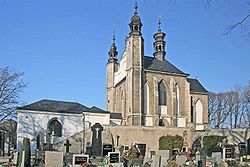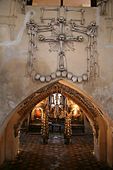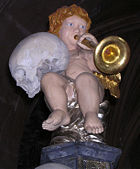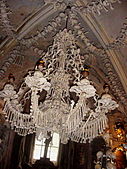- Sedlec Ossuary
-
Coordinates: 49°57′43.04″N 15°17′17.85″E / 49.9619556°N 15.2882917°E
The Sedlec Ossuary (Czech: kostnice Sedlec) is a small Roman Catholic chapel, located beneath the Cemetery Church of All Saints (Czech: Hřbitovní kostel Všech Svatých) in Sedlec, a suburb of Kutná Hora in the Czech Republic. The ossuary is estimated to contain the skeletons of between 40,000 and 70,000 people, many of whom have had their bones artistically arranged to form decorations and furnishings for the chapel. The ossuary is among the most visited tourist attractions of the Czech Republic, attracting over 200 thousand visitors yearly.[1]
Contents
History
Henry, the abbot of the Cistercian monastery in Sedlec, was sent to the Palestine (Holy Land) by King Otakar II of Bohemia in 1278. When he returned, he brought with him a small amount of earth he had removed from Golgotha and sprinkled it over the abbey cemetery. The word of this pious act soon spread and the cemetery in Sedlec became a desirable burial site throughout Central Europe. During the Black Death in the mid 14th century, and after the Hussite Wars in the early 15th century, many thousands were buried there and the cemetery had to be greatly enlarged.
Around 1400 a Gothic church was built in the center of the cemetery with a vaulted upper level and a lower chapel to be used as an ossuary for the mass graves unearthed during construction, or simply slated for demolition to make room for new burials. After 1511 the task of exhuming skeletons and stacking their bones in the chapel was, according to legend, given to a half-blind monk of the order.
Between 1703 and 1710 a new entrance was constructed to support the front wall, which was leaning outward, and the upper chapel was rebuilt. This work, in the Czech Baroque style, was designed by Jan Santini Aichel.
In 1870, František Rint, a woodcarver, was employed by the Schwarzenberg family to put the bone heaps into order. The macabre result of his effort speaks for itself. Four enormous bell-shaped mounds occupy the corners of the chapel. An enormous chandelier of bones, which contains at least one of every bone in the human body, hangs from the center of the nave with garlands of skulls draping the vault. Other works include piers and monstrances flanking the altar, a large Schwarzenberg coat-of-arms, and the signature of Rint, also executed in bone, on the wall near the entrance.
In media
In 1970, the centenary of Rint's contributions, Czech filmmaker Jan Švankmajer was commissioned to document the ossuary. The result was a 10 minute long frantic-cut film of skeletal images overdubbed with an actual tour-guide's neutral voice narration. This version was initially banned by the Czech Communist authorities for alleged subversion, and the soundtrack was replaced by a brief spoken introduction and a jazz arrangement by Zdeněk Liška of the poem "Comment dessiner le portrait d'un oiseau" ("How to Draw the Portrait of a Bird") by Jacques Prévert. Since the Velvet Revolution, the original tour guide soundtrack has been made available.
In the documentary Long Way Round, Ewan McGregor and Charley Boorman stop to see this church. Dan Cruickshank also views the church in his Adventures in Architecture. It is a major plot device in the John Connolly novel The Black Angel and used as a location for the Dungeons & Dragons movie and the movie Blood & Chocolate. It was also featured in Ripley's Believe it or Not and is described by Cara Seymour in the final scene of the film Adaptation. It was also the influence for Dr. Satan's lair in the Rob Zombie film House of 1000 Corpses.[citation needed]
The Sedlec Ossuary EntranceSignature of F. Rint written with bonesA close up of a decorationSchwarzenberg coat-of-arms made with bonesChandelier made of bones and skullsCoins left as offeringReferences
References and external links
- Official website (cz, en, de)
Categories:- Ossuaries
- World Heritage Sites in the Czech Republic
- Kutná Hora
- Roman Catholic cemeteries
- Cemeteries in the Czech Republic
Wikimedia Foundation. 2010.








